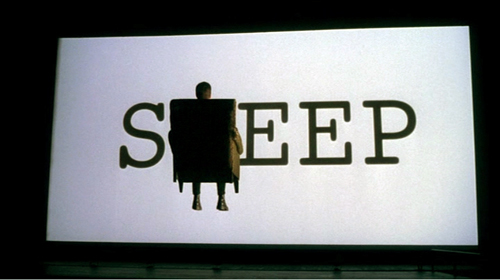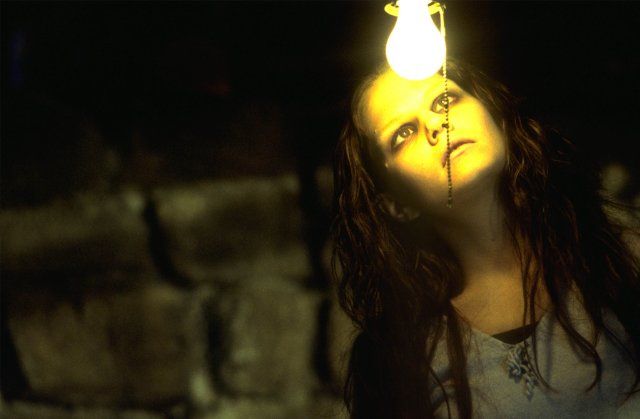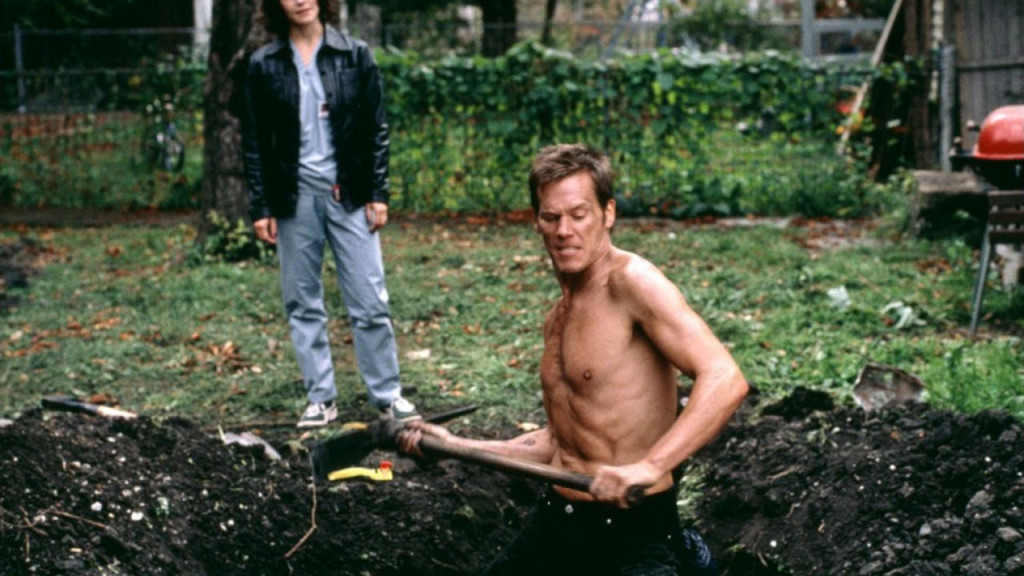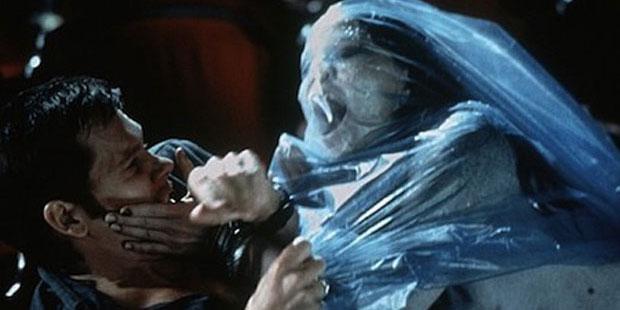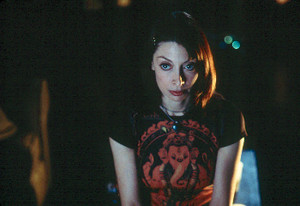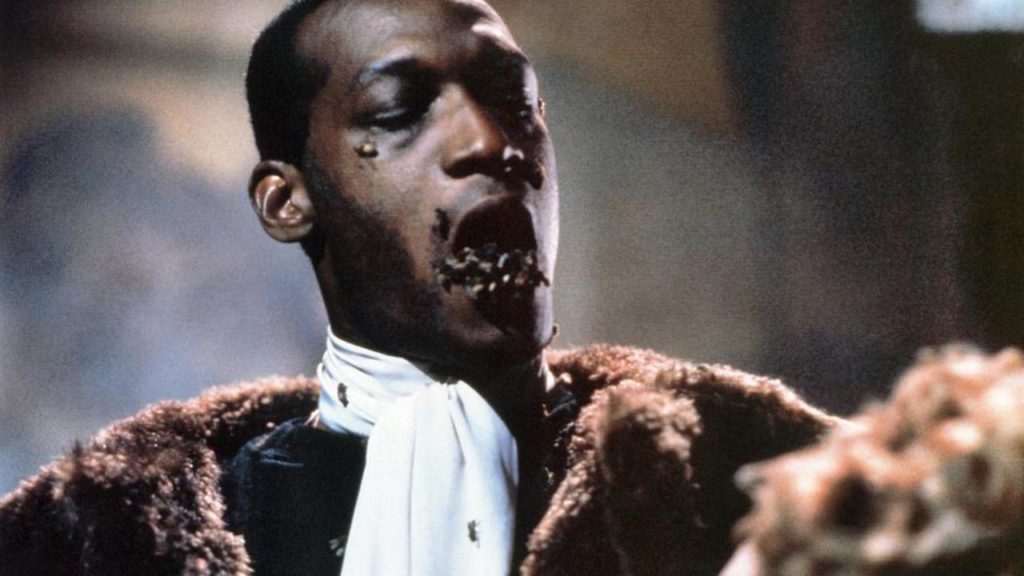
Candyman handles bees in the face way better than Nic Cage did in The Wicker Man.
This January, in support of the Toronto Rape Crisis Centre / Multicultural Women Against Rape, friends and family have raised over $1,000, which means I have to watch and write about thirty-one horror movies. I’ll watch (on average) one movie a night, many of them requested by donors, after which I’ll write some things about said movies on this website. Be forewarned that all such write-ups will contain spoilers! Last night’s film was Candyman, directed by Bernard Rose (Immortal Beloved), and suggested by donor Darla Woodley. Though I’ve never met Darla Woodley, we collaborated on a children’s book together! Darla’s book, called Red Socks Go with Absolutely Anything, is a encouraging story about how a simple pair of red socks can give a child a little boost when they are feeling out of their comfort zone. Don’t be misled by the fact that Woodley recommended the gory and depraved Candyman, her children’s book is quite delightful. Candyman was rented from my (maybe) friends at Queen Video.
What happens:
Based on a short story by horror writer Clive Barker called “The Forbidden,” Candyman is that rare beast: an urban horror film. Whereas so many horror movies take place in remote cabins and mountaintop villas, so few happen in the heart of a major city. Candyman is set in The City with Big Shoulders, Chicago. The film opens with a voiceover by (we can assume) the Candyman himself – not to be confused with Rene from Danish pop band Aqua – who asks us while the screen fills with bees, “What’s blood for, if not for shedding?” (I feel like a hematologist would have a lot of good answers to this question.) Then he warns that with his hook for hand, he’ll split us from groin to gullet. Then a swarm of bees envelops Chicago, just like in a Wu-Tang video.
A woman begins to tell Helen Lyle (Virginia Madsen, looking a lot like Madonna) a “true story,” she claims. A friend of a friend, Clara, was babysitting when local bad boy, Billy, came over. She tells him the legend of Candyman: if you say “Candyman” five times in the mirror, this guy with a bloody stump for a hand that has a hook protruding from the hand’s meat (gross!) will appear. They say his name four times in the bathroom mirror while Billy begins to undress Clara. They chicken out at four, and Billy heads downstairs. But Clara, left alone in the washroom, says it one last time. She was found split open by a hook, and the baby was killed, as well. Only Billy survived the encounter and went insane soon afterward.

“Candyman? I bought you a really nice coat …”
Why is this woman telling Helen Lyle this gruesome story? That’s because Helen is a university researcher a the University of Illinois, who, with friend Bernadette Walsh (Kasi Lemmons), is gathering stories about urban legends for her thesis. Helen in married to professor Trevor Lyle (Xander Berkeley), who when we first see him is lecturing about alligators in the sewers. Helen sits in on the end of the class, then chases away eager student Stacey (Carolyn Lowery), who’s been making eyes at her husband. She scolds Trevor for lecturing on urban legends, as she wanted him to wait until she and Bernadette were done their thesis. She asks him about Stacey and Trevor is offended at the suggestion of any impropriety with one of his students.
Working late, Helen meets the custodian, Henrietta Moseley (Barbara Alston), who – after overhearing Helen’s recorded interviews – says she has a friend who lives in Cabrini-Green, Chicago’s somewhat infamous housing projects, who knows someone killed by the Candyman. Henrietta retrieves her fellow custodian, Kitty, who recounts the story of a girl named Ruthie Jean, who was killed by someone who broke into her apartment through the medicine cabinet. Intrigued, Helen goes through microfilm of Chicago newspapers and discovers there actually was a woman named Ruthie Jean who was murdered in Cabrini-Green. Maybe there is some truth behind this urban legend.
At her and Trevor’s apartment, Helen shows Bernadette some of the recent research she’s done. She displays for her the printouts of the Ruthie Jean murder and asks Bernadette if she notices anything. The building in Cabrini-Green and Helen’s own apartment are the same building. Her condo building was originally built as a housing project, but then city planners realized there was no barrier like a highway to keep the building closed off from the rest of the city, so they turned it into high-end condominiums. (Sounds familiar.) Helen shows Bernadette that the project building layout has a trick wall behind the medicine cabinet – you could easily enter into the unit next door. They then dare each other to play “Candyman” in the mirror, but only Helen is willing to say it five times. To give the audience its first decent jump scare, Trevor arrives home drunk late at night and leaps on Helen in bed, terrifying her something good. (Virginia Madsen is not a great screamer: she’s no Jamie Lee Curtis.)
The next morning, Helen and Bernadette drive to Cabrini-Green. Some first-person accounts will lend credence to their thesis that a disadvantaged urban group has taken to attributing the daily horrors of life in the projects to a mythical creature. But they drive with some trepidation, given the stories they’ve heard about gangs in the area. (Bernadette has brought mace along.) Bernadette is also worried that they look like cops with the way they’re dressed, and her fears are not unfounded. As soon as they exit their car, local toughs begin catcalling them and warning the neighbourhood that the “5-0″ has arrived.
Undeterred – though a little nervous – they head upstairs toward Ruthie Jean’s old apartment. On the way, Helen is distracted by some really neat graffiti – “SWEETS TO THE SWEET” – and has to take a bunch of photos like a run-of-the-mill poverty tourist. She’s suddenly scared by a nearby apartment’s Rottweiler. The dog’s owner – a housekeeper, by her uniform – makes the dog heel and returns inside. Helen and Bernadette enter the abandoned apartment and Helen discovers the layout is identical to her own (though it’s obviously not in quite the same shape). The mirror in the washroom is in pretty good shape, but the back wall of the medicine cabinet was torn open some time ago. Helen wants to crawl through to the other side, but Bernadette attempts to stop her. Helen pushes ahead, walking through a circular doorway that serves as the mouth of a mural illustration. On the floor, she finds a nest of wrapped candy with razorblades inside – another urban legend seemingly come to life! Eventually, the housekeeper next door asks what the two women are doing. “Whites don’t ever come here, ‘kept to cause us problems,” she notes. They enter the apartment of the woman, Anne-Marie McCoy (Vanessa Williams), who is caring for a young baby, Anthony. Anne-Marie knows they’ve come because of Ruthie Jean. She asserts that the Candyman is real, and he’ll never be caught.

Helen and Bernadette discuss Candyman, whether or not he is really from Bountyland.
Over a self-important academic luncheon, Helen tells her advisor, Professor Philip Purcell (Michael Culkin), who also has an interest in urban legends, that her work is going to put his to shame. He laughs condescendingly and Helen reveals that they’ve been to Cabrini-Green recently. Purcell immediately recognizes that they’re investigating the Candyman. An expert on the subject, he outlines the legend of the Candyman. The legend first appeared in 1890. Candyman was the son of a slave who became wealthy (and a free man, I guess?) through the invention of a cobbling device. The man’s son (Candyman) grew up in high society and showed a talent for art, eventually becoming a portrait artist. A landowner hired him to paint his daughter, but the artist and daughter fell in love and the daughter soon became pregnant. The landowner, horrified that a black man had impregnated his daughter, hired “local hooligans” to exact his revenge. They chased him to Cabrini-Green where they sawed off his drawing hand with a rusty saw. Then they smeared him with honey and let loose some bees from the nearby apiary. (That was handy.) The bees stung him to death, but for good measure, the goons also set fire to his body.
Helen returns to Cabrini-Green on her own. Anne-Marie is at work, but a neighbourhood kid, Jake (DeJuan Guy), is loitering in the hallway. She asks Jake if he knows about Ruthie Green, and Jake admits he does, but he can’t talk about it. The Candyman will get him. Helen bargains with Jake: if he just shows him something, but doesn’t say anything, it would be their little secret and the Candyman would never know. Winning the child over with this logic, Helen follows Jake past a massive pile of trash – apparently the future site of a bonfire – to a desolate public washroom. Jake tells her a horrible story about what happened inside.
A developmentally challenged child, Charlie, had to go to the washroom. His mom, shopping in a store across the street, became frustrated with him, and sent him across the street to the washroom on his own. That’s when she heard screaming. A big tough guy from the neighbourhood ran inside and staggered out, his hair now entirely white. And what happened to Charlie, Jake says, was worse than death. In flashback, we see the boy, clutching his crotch, screaming in a pool of blood on the tiled floor. The toilet itself, is splattered with blood and gore. Not spooked enough by this horror story, Helen enters the washroom to check it out on her own.
She enters the washroom and is overcome by a powerful stench. Someone has written “SWEETS TO THE SWEET” on the walls with human excrement. Also written in poo: an arrow pointing to a toilet. Helen opens the lid and finds the toilet bowl full of swarming bees (which, to be honest, is probably one of the better things that could have been inside). As she turns to leave a tall man in a black trench coat enters and brandishes a hook (though he clearly has two hands). A number of other goons enter and corner Helen in the washroom. One holds her hands behind her and the hook man says, “I hear you’re looking for the Candyman, bitch. Well, you found him.” Then he smacks her across the head with the hook.
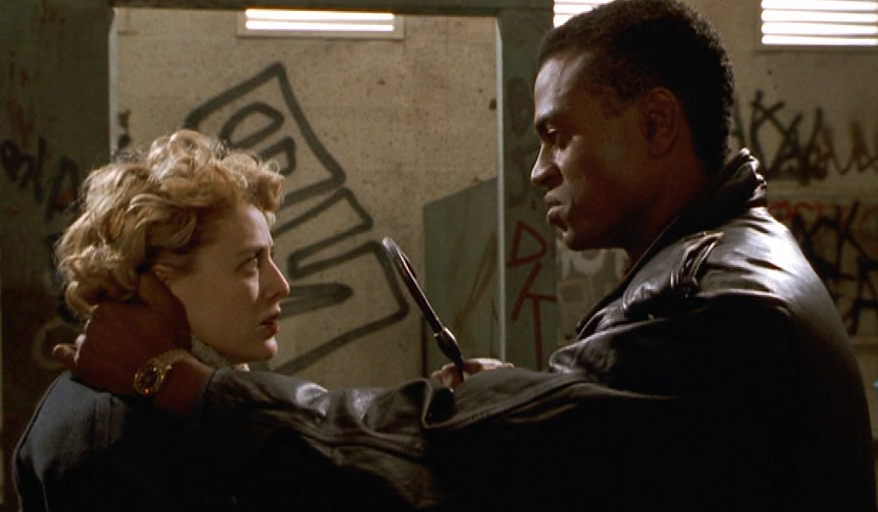
False alarm: this is just a candyman, not THE Candyman.
Helen, with a prominent black eye, sits in a police precinct and identifies the Candyman from a police lineup. The detective, Frank Valento (Gilbert Lewis) congratulates her. “Did he kill Ruthie Jean?” Helen asks. The detective is certain that this “Candyman,” who runs local gang The Overlords, is responsible for that and a number of murders. But no one would testify against him before, as the police have a hard time protecting eyewitnesses in the projects. Jake, who found the unconscious Helen, is waiting in the police reception, and Helen thanks him for saving her life. Jake, however, is less than enthusiastic. He says that Helen told their secret, and now the Candyman will get him. Helen assures him that the Candyman isn’t real. It was just a hoax the local gang leader exploited to intimidate people.
When Helen recovers enough to return to the university, Bernadette gives her a box of slides developed from her photos of Cabrini-Green. And Bernadette has more good news: it sounds like publishers have taken an interest in Helen’s work. Helen, pretty darn pleased with herself, begins to inspect the slides on the way to her car, when a dapper man follows her into the aboveground parking garage. In his deep voice, smooth as oiled leather, the man calls for Helen. He stands at the far end of the garage in a full-length fur coat. Also – quite noticeably – he has a hook protruding from the bloody pulp has has for a hand. Looks like this might be the genuine article Candyman (Tony Todd)! He tells Helen that he came for her, and she, seemingly mesmerized, doesn’t know what to do. “Be my victim,” he insists. That’s when Helen blacks out.
When she opens her eyes, she’s lying on the floor of a strange washroom, covered in blood. A woman screams outside the locked door. Helen opens the door and sees that the trail of blood leads to the severed head of a Rottweiler. She’s in Anne-Marie’s apartment! Helen picks up a discarded meat cleaver (clearly the weapon in the dog beheading) and goes to the bedroom, where Anne-Marie is screaming in front of an empty crib that’s covered in blood. She turns to see Helen and calls her a murderer. Anne-Marie knocks Helen down and begins to smash her head against the floor. Helen retaliates by slicing her shoulder with the cleaver. When the police burst in, Helen has the cleaver held to Anne-Marie’s head.
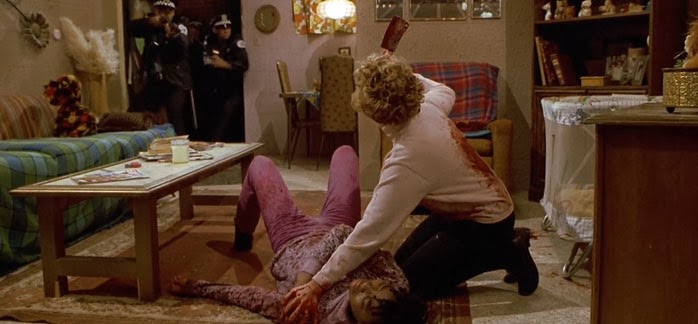
Helen’s knife sales pitch goes a little too far.
Detective Frank Valento, very disappointed in his star witness, tells Helen she’s being arrested. The Chicago police treat dog decapitation as a pretty serious crime and, besides, Anne-Marie’s baby has gone missing. Helen makes her one state-sanctioned phone call to Trevor, but he’s not home. (It’s 3 AM, Trevor! Where are you at?) In her jail cell that night, Helen dreams of the Candyman, who holds Anthony hostage in his creepy apartment in Cabrini-Green. The next morning, Trevor and his lawyer bail Helen out and they fight through a media circus to escape home.
Helen hasn’t been charged yet because the police are hoping to find Anthony’s body so they can charge Helen with first-degree murder. She asks Trevor where he was last night, and he claims to have been fast asleep. Helen relaxes in the tub, and though Trevor worries about leaving her alone for any period of time, he goes to retrieve some papers from the university anyway. While home alone, Helen fires up the old carousel and views the slides she took in the Cabrini-Green projects. In one photograph, where she stands in front of a broken mirror, she spots a dark figure looming over her shoulder. Is it the Candyman? Helen goes to her bathroom vanity but doesn’t speak a word. She opens the cabinet door and a hook hand shoots out of the inside, swatting at her. Helen dashes from the apartment into the hallway, but the man in the fur coat waits for her at the end of the hall, beckoning Helen with his velvet-smooth voice. He is upset with Helen: her disbelief has destroyed his congregation.
Helen locks herself in the apartment and tries to call for help, but the Candyman just appears inside her living room. Helen crumples to the floor, and – like Jon Hamm with Tina Fey – the Candyman caresses her with his hook, blood running down her neck. Bernadette arrives with flowers at the apartment door and rings the bell. Helen yells at her friend to leave, but Berandette, concerned with all the shouting, forces her way in and is surprised by the Candyman. A lot of screams and wet ripping sounds follow. Trevor returns home moments later and finds Helen unconscious on the floor, butcher knife in her hand and blood drenching her clothes. When Helen comes to, she’s been handcuffed in her own bed – and not in a sexy way. The police are on the scene – the murder scene, that is. Helen runs to the living room, hands tied behind her back, and sees upon the floor the gruesome body of Bernadette, cut up the middle.
Helen hears the Candyman in her head now, is haunted by visions of his ruined apartment, dripping with blood. Candyman loves being dead, he tells her. It’s so much better living in dreams and nightmares. Helen is taken to a mental hospital and strapped to a gurney. While she struggles with her manacles, Candyman appears to her, floating just above her body. Helen begins to scream and flop around until the orderlies must sedate her. Later, Helen is wheeled to the office of Dr. Burke (Stanley De Santis), who reveals that she’s been in the hospital for a full month, mostly under the influence of thorazine. Her trial for the first-degree murder of Bernadette Walsh will begin soon, and Burke is to assess her ability to stand trial. Burke then shows her the video from the night she was admitted – there was no Candyman over her gurney at all. She imagined it all!

Candyman learned the hard way how difficult it is to get bloodstains out of fur.
Desperate to believe she hasn’t lost her mind, Helen says she’ll prove that Candyman exists. She turns to face a mirror in the office and summons him. Nothing happens. But then Dr. Burke starts choking and sputtering blood. Candyman appears, goring the psychiatrist from behind. Once Burke has been thoroughly gutted, Candyman frees Helen from her bonds then leaps backwards, smashing through the office window. Helen follows, crawling along the building’s ledge. Eventually she finds the window to another hospital room and, entering, quickly knocks out the nurse inside. She steals her uniform and escapes from the hospital. All thanks to the Candyman.
Naturally, she runs to Trevor’s apartment, where the door has been left open. But – betrayal of betrayals – his student Stacey has seemingly shacked up with him, and the two are painting the apartment, a symbol of new love heretofore only seen in bank advertisements. Helen, incredibly hurt, starts to pace the apartment and toss paint buckets at the wall. When Stacey goes to reach for the telephone, Helen snaps at her. She burns holes into Trevor’s forehead with her thousand-yard stare (not literally, of course) and growls, “What’s the matter, Trevor? Scared of something?” She storms out and Trevor immediately dials the hospital.
The lost Helen seeks guidance from the Chicago River, and Candyman, still in her head, tells her to come to him, for “All you have left is my desire for you.” Helen returns to the projects in Cabrini-Green and finds the apartment hidden behind the medicine cabinet. In the interim, someone went to Chapters or Pottery Barn and bought a whole bunch of votive candles to spruce the place up. Helen finds a hook on the floor, then proceeds upward. In a very messy room – Candyman is a true bachelor – Helen finds her fur-coated tormenter asleep on a stone table. She raises her hook above her head and as he wakes, drives the hook into his neck. But it has no effect.
Helen can’t defeat Candyman, it seems, so she takes him up on his offer. If she surrenders herself to him, Candyman will return Anne-Marie’s child unharmed. She acquiesces, and Candyman begins to lift her skirt with his bloody hook hand. “Come with me and be immortal,” he suggests, and opens his coat to reveal a rib cage filled with swarming bees. His mouth is also full of bees now, and he swoops in for a deep, bee-filled kiss with Helen. She wakes up, brushing imaginary bees from her mouth. Helen is now back in the original candlelit apartment, the hook still in her hand. However, a new message and new mural is on the wall. Over a fresco that seems to depict Candyman’s origin story is the message: “IT WAS ALWAYS YOU, HELEN.”

John Cusack had his boom box and Peter Gabriel song; Candyman had to improvise.
A baby’s cry pierces the cold Chicago air; it appears to be coming from the trash mountain. (They plan well ahead for bonfires in the projects.) Helen begins to climb Mount Trashmore to find the infant Anthony. Jake, meanwhile, is awakened by the commotion. When he goes to his window, he sees a hook (Helen’s) slip into the mound of garbage. “He’s here,” Jake whispers. While Helen roots around in the immense pile of trash, Jake and some older friends douse the mountain in gasoline. They set it ablaze and soon the whole neighbourhood comes out into the streets to enjoy the bonfire. Helen finds the baby just as flames begin to surround her. That’s when Candyman appears behind her, muffling her mouth.
The crowd chants, “Burn him! Burn him!,” and Helen – finally breaking free from Candyman – picks up a flaming stick and drives it into Candyman’s belly. He flails around, causing some of the flaming trash to fall onto Helen’s back. Eventually, she scrambles out of the flaming garbage heap. Her back and hair have caught on fire, but she’s managed to protect the baby. Anne-Marie can’t believe what she’s seeing. Neighbours smother the flames and take Anthony from her, but Helen’s head and back are covered in third-degree burns; her ears even seem to have melted off. Candyman, trapped in the flames, howls, “Come back to me!” as he is swallowed by the fire. Jake can see his charred corpse among the garbage: Candyman was real.
Helen apparently had no friends, as her funeral is attended only by Trevor, his new girlfriend Stacey, and those two other professors from the luncheon. But then a procession of all the hundreds of people from Cabrini-Green, led by Anne-Marie and Jake arrives to pay their respects. Jake takes Candyman’s hook and drops it into the open grave. In the final scene of the film, Trevor, overcome with grief, hides in the bathroom from Stacey. He cries over Helen while Stacey reluctantly makes dinner solo with the largest butcher knife I’ve ever seen. Trevor, a total mess, gazes into the vanity mirror and says “Helen” five times. She appears, burns upon her naked scalp and a hook for a hand. She quotes herself – “What’s the matter, Trevor? Scared of something?” – and stabs him in the gut. When Stacey goes to the washroom to check on her professor boyfriend, she finds him in the tub, completely disembowelled. Stacey screams and the camera zooms in on a mural of a saintly Helen Lyle on some project apartment wall.
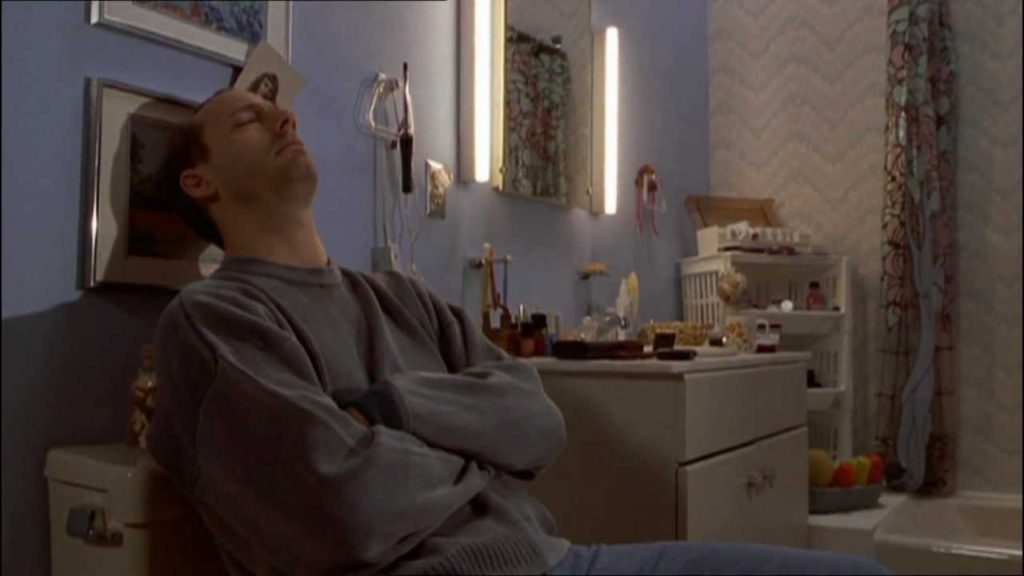
Trevor has all his most regretful thoughts on the toilet.
Takeaway points:
- A better name for Candyman might be White Privilege: The Movie. One might be tempted to think today’s current focus on white privilege is something relatively new, but obviously it was front of mind in 1992. Helen outlines the issue pretty clearly: “Two people get brutally murdered and nothing happens. A white woman gets beat up and the police lock the place down.” This is the principle that underlies the Black Lives Matter movement (aside from the fact that Black Lives Matter explicitly concerns police killings, and not Candyman killings). Helen and her upper-middle-class black friend Bernadette are terrified to enter Cabrini-Green, not even realizing their fears are based on stories that are as much an urban legend as the sewer alligators Trevor jokes about. The movie also interrogates the idea of mining other cultures for material. After all, two academics head into the projects to take the stories of disadvantaged racialized people in order to prove their thesis, which is troubling, no matter how good the intentions of their project. It’s telling that the horror experienced by the black characters manifests in actual bodily harm: castration, infant abduction, death. The horror experienced by our white protagonist is that she is being accused of murder. The black characters fear actual pain; the white character fears being labelled. If that’s not white privilege, I don’t know what is.
- The film treads the fine line between representing and stereotyping black culture. The sad fact is, it was novel to see so many black characters in a horror film. And particularly cool to see Tony Todd as perhaps the most charming movie monster since Dracula. At the same time, Candyman – particularly given his origin story – could be viewed as an egregious stereotype of the black seducer, come to “steal all the white women.” More troubling is how Helen effectively becomes saviour to the black community in the finale. The project residents pay their respects as if Helen were Atticus Finch leaving the courtroom. The final shot almost turns her into the Patron Saint of Cabrini-Green. Despite those two issues, Candyman generally handles issues of race well, explicitly interrogating white privilege (see above), for instance, or describing how city planners aimed to keep black communities from the rest of the city via physical barriers like highways. Candyman also shot on location at the real Cabrini-Green housing projects, using local people as extras.
- The music in Candyman was composed by modern American composer Philip Glass! It’s strange this horror movie features an original Glass score, but the incredible gothic soundtrack really adds another dimension to the film. It effectively helps create what is, in essence, an Inner-city Gothic. Apparently, Glass claims he was misled about the project, believing he was working on an artistic independent film project rather than a low-budget slasher pic. But he has since come to terms with the film.
- Apparently those are real bees swarming all over Tony Todd and Virginia Madsen! They were specially bred for the movie to look like mature bees, even though they were adolescents whose stingers would do less damage. Todd actually had a mouth full of bees, with only a mouthguard to keep the bees from flying down his throat. Madsen is allergic to bees, so an ambulance was on set whenever a bee sequence was in effect. Celebrities: they’re just like us!
Truly terrifying or truly terrible?: I’d be willing to categorize Candyman as terrifying. But it’s also just an entertaining, well-made movie, with a little more (overt) interest in social issues than the average horror film.
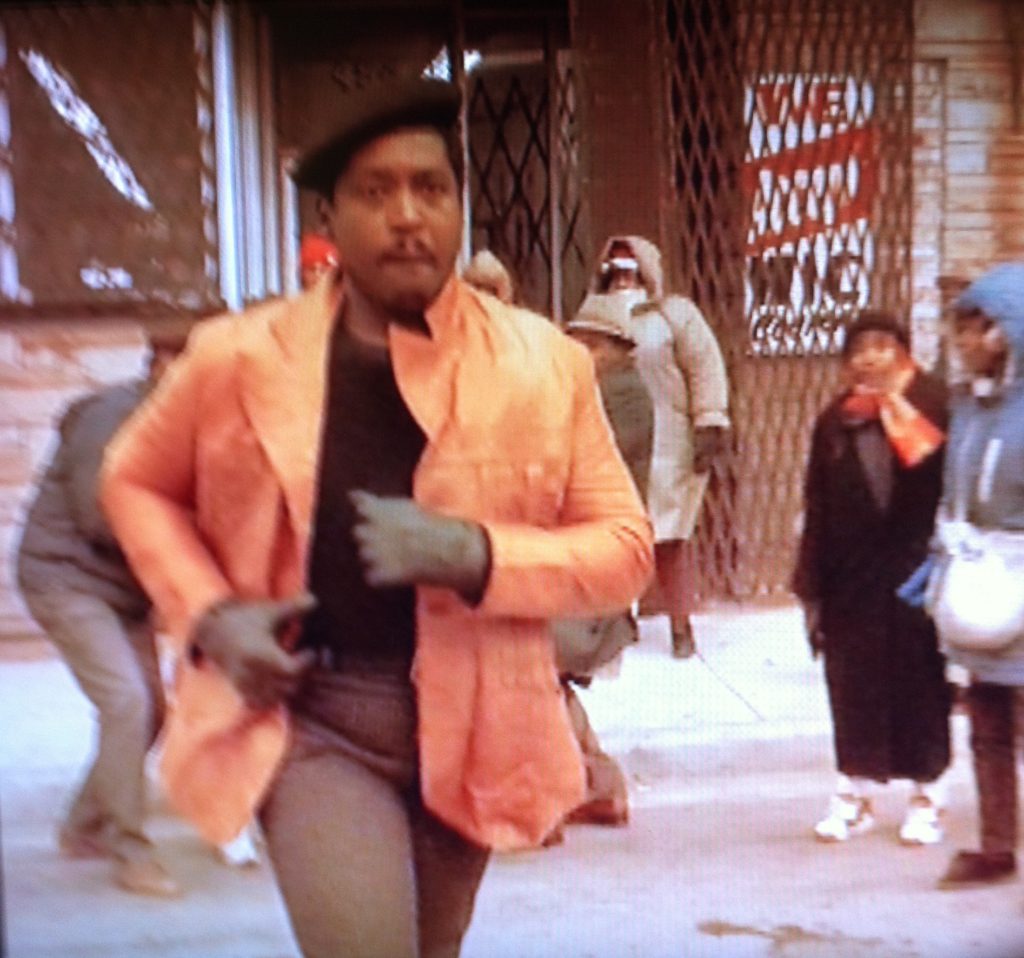
Say hello to the toughest – and best-dressed – man in Cabrini-Green.
Best outfit: Helen Lyle has some really great outfits, including a ribbed blue sweater that she wears with brown leather gloves. And I could write an entire essay on Trevor’s patterned vest. But nothing beats the killer look of a character who barely has one scene: “the big, tough guy” from Jake’s flashback, complete with an amber leather coat and beret.
Best line: “What if someone’s packin’ drugs in there?” – a concerned Bernadette Walsh, making up slang as she goes along
Best kill: That’s a tough call. The castrated boy in the washroom is probably the most disturbing, but it’s a little too unsettling (and not really a “kill”). Watching Dr. Burke sputter up blood in his office was much more fun.
Unexpected cameo: Ted Raimi (brother of Sam, co-star of SeaQuest: DSV), looking thirty-five, plays rebel teen Billy from the story that opens the movie. But even better than a Ted Raimi appearance – which is pretty awesome – is that Gilbert Lewis, who plays Detective Frank Valento, sometimes played The King of Cartoons on Pee-Wee’s Playhouse. In object cameos, booksellers will be amused to see an Ingram shipping box among the assembled junk in Trevor’s paint-ready apartment.
Unexpected lesson(s) learned: You can afford the bail for dog beheading and child abduction on an adjunct professor’s salary.
Most suitable band name derived from the movie: The Overlords. Or Cabrini-Green.
Next up: Prophecy (1979).

